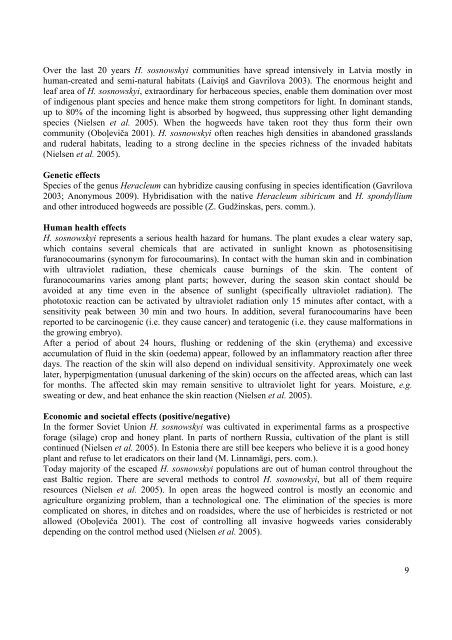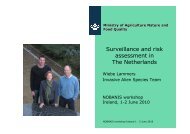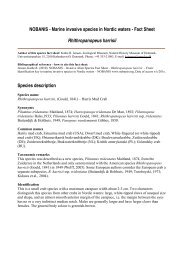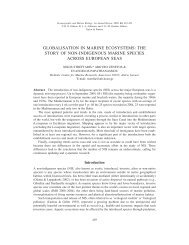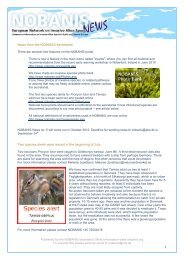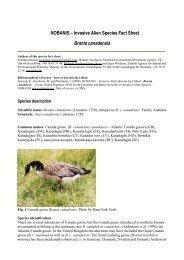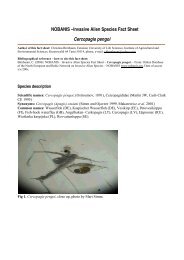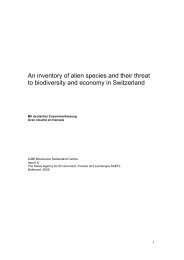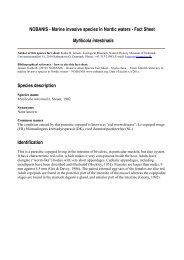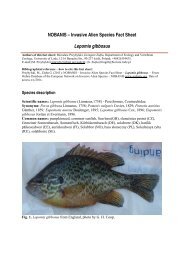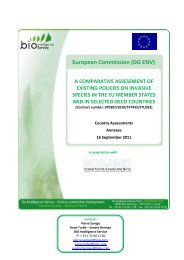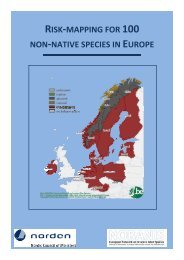NOBANIS – Invasive Alien Species Fact Sheet Heracleum sosnowskyi
NOBANIS – Invasive Alien Species Fact Sheet Heracleum sosnowskyi
NOBANIS – Invasive Alien Species Fact Sheet Heracleum sosnowskyi
You also want an ePaper? Increase the reach of your titles
YUMPU automatically turns print PDFs into web optimized ePapers that Google loves.
Over the last 20 years H. <strong>sosnowskyi</strong> communities have spread intensively in Latvia mostly in<br />
human-created and semi-natural habitats (Laiviņš and Gavrilova 2003). The enormous height and<br />
leaf area of H. <strong>sosnowskyi</strong>, extraordinary for herbaceous species, enable them domination over most<br />
of indigenous plant species and hence make them strong competitors for light. In dominant stands,<br />
up to 80% of the incoming light is absorbed by hogweed, thus suppressing other light demanding<br />
species (Nielsen et al. 2005). When the hogweeds have taken root they thus form their own<br />
community (Oboļeviča 2001). H. <strong>sosnowskyi</strong> often reaches high densities in abandoned grasslands<br />
and ruderal habitats, leading to a strong decline in the species richness of the invaded habitats<br />
(Nielsen et al. 2005).<br />
Genetic effects<br />
<strong>Species</strong> of the genus <strong>Heracleum</strong> can hybridize causing confusing in species identification (Gavrilova<br />
2003; Anonymous 2009). Hybridisation with the native <strong>Heracleum</strong> sibiricum and H. spondyllium<br />
and other introduced hogweeds are possible (Z. Gudžinskas, pers. comm.).<br />
Human health effects<br />
H. <strong>sosnowskyi</strong> represents a serious health hazard for humans. The plant exudes a clear watery sap,<br />
which contains several chemicals that are activated in sunlight known as photosensitising<br />
furanocoumarins (synonym for furocoumarins). In contact with the human skin and in combination<br />
with ultraviolet radiation, these chemicals cause burnings of the skin. The content of<br />
furanocoumarins varies among plant parts; however, during the season skin contact should be<br />
avoided at any time even in the absence of sunlight (specifically ultraviolet radiation). The<br />
phototoxic reaction can be activated by ultraviolet radiation only 15 minutes after contact, with a<br />
sensitivity peak between 30 min and two hours. In addition, several furanocoumarins have been<br />
reported to be carcinogenic (i.e. they cause cancer) and teratogenic (i.e. they cause malformations in<br />
the growing embryo).<br />
After a period of about 24 hours, flushing or reddening of the skin (erythema) and excessive<br />
accumulation of fluid in the skin (oedema) appear, followed by an inflammatory reaction after three<br />
days. The reaction of the skin will also depend on individual sensitivity. Approximately one week<br />
later, hyperpigmentation (unusual darkening of the skin) occurs on the affected areas, which can last<br />
for months. The affected skin may remain sensitive to ultraviolet light for years. Moisture, e.g.<br />
sweating or dew, and heat enhance the skin reaction (Nielsen et al. 2005).<br />
Economic and societal effects (positive/negative)<br />
In the former Soviet Union H. <strong>sosnowskyi</strong> was cultivated in experimental farms as a prospective<br />
forage (silage) crop and honey plant. In parts of northern Russia, cultivation of the plant is still<br />
continued (Nielsen et al. 2005). In Estonia there are still bee keepers who believe it is a good honey<br />
plant and refuse to let eradicators on their land (M. Linnamägi, pers. com.).<br />
Today majority of the escaped H. <strong>sosnowskyi</strong> populations are out of human control throughout the<br />
east Baltic region. There are several methods to control H. <strong>sosnowskyi</strong>, but all of them require<br />
resources (Nielsen et al. 2005). In open areas the hogweed control is mostly an economic and<br />
agriculture organizing problem, than a technological one. The elimination of the species is more<br />
complicated on shores, in ditches and on roadsides, where the use of herbicides is restricted or not<br />
allowed (Oboļeviča 2001). The cost of controlling all invasive hogweeds varies considerably<br />
depending on the control method used (Nielsen et al. 2005).<br />
9


